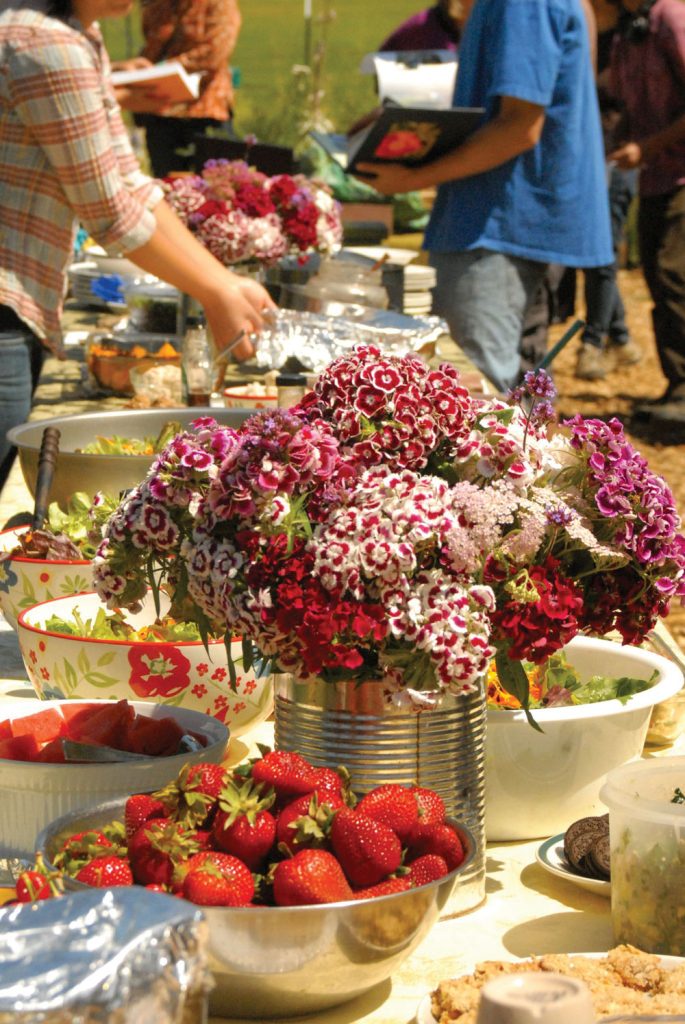Over the last 5 years or so my formal Zen practice has begun to dematerialize, dropping down below the horizon where blue earthworms mix raw manure with the guts of the ground. For original teaching I summon the first Zen pilgrims who came to North America in the early 20th century. Nyogen Senzaki spent 20 years working as a farmhand, a waiter, a houseboy, and a translator before establishing practice places in Los Angeles and San Francisco. “Zen is not a puzzle,” he insisted. “It cannot be solved by wit. It is spiritual food for those who want to learn what life is . . .”
A few decades later in the 1960s when Shunryu Suzuki Roshi was living in California, he encouraged Zen students to study the emptiness of the ground and learn how to produce food from this field. If you look at the empty garden, he taught, you won’t see anything. Yet when you take care of the seed, it comes up.
In 1965, a few years after Suzuki Roshi arrived in San Francisco, the Teikei movement of community-supported agriculture began in Japan, founded by a group of women alarmed over the rising tide of pesticide use in their country and by the decrease in the quality of food and lifestyle for Japanese people and farmers. Teikei means “partnership” or “cooperation,” and is often associated with the slogan, “food with the farmer’s face on it.” Close to 50 years ago, Japanese farmers applied their practice of looking at the empty ground with a sense of spirited relationship, and the seeds of community-supported agriculture germinated and flourished. Now in the United States thousands of CSA programs have spread from the underground root system of the original Japanese teikei movement.
These days my Zen training is best applied sparsely as above- and below- ground fertilizer to help establish fresh community-supported agriculture programs for a hungry world. As the pace of global climate change quickens, I want to slow down the inquiry. To grow food with the farmer’s face on it demands gravity and creative partnership. This spring, at the Indian Valley Organic Farm and Garden where I have been teaching for the last five years on the campus of our local community college, we have just initiated such a partnership with the Cultural Conservancy, a nonprofit indigenous rights organization based in San Francisco. The Cultural Conservancy is directed by a treasured friend and colleague, Melissa Nelson, a Turtle Mountain Chippewa writer, educator, and environmental leader who has served as president of the organization for 20 years while also teaching as a professor of Native American studies since 2002.
The Cultural Conservancy works at the bright edge of indigenous health and food sovereignty issues as a flintstone for Native Foodways programs. In this new partnership with the Indian Valley Organic Farm and Garden, Bay Area Native Americans who are landless will have direct access to “the emptiness of the ground,” invited to grow traditional food and to cultivate embodied knowledge of persistent agriculture.
In late May of this year, at the close of the academic semester, we formally inaugurated our partnership with a celebratory day of planting and feasting. In ceremony, the leaders of our programs entrusted a California native soaproot plant to the windy two-acre hillside above the farm that is designated as the future enthnobotanical site for our collaboration. Then we descended through hip-high purple needlegrass, wild oats, and owl’s clover to a 200-foot-long bed of open land designated for growing seed of the sacred trio of the Three Sisters: corn, beans, and squash.
During the Three Sisters planting, Kaylena Bray, a young Haudenosaunee Seneca leader who serves as garden program coordinator and social media consultant for the Cultural Conservancy, planted a generous measure of Iroquois white corn, grown by her family for 70 years. Kaylena’s father, David Bray, has farmed for nearly his entire life in western New York on land cultivated by his family for three generations. In addition to the Iroquois white corn seed that David donated, he offered traditional bear beans and strawberry beans to plant at Indian Valley. Kaylena’s parents plan to visit her in late autumn to help harvest the seed of these traditional crops alongside a team of us enhanced with local native youth from the Seventh Native American Generation (SNAG) program.
Once the heirloom seed was planted and watered, we gathered around a feast table set out in the field, heavy with the bounty of local and indigenous food. Fresh slabs of white farm cheese and the first press of Indian Valley olive oil was served alongside Iroquois corn dumplings flavored with thick amber maple syrup and placed next to a bowl of wild rice from Melissa’s maternal homeland. A large spiral platter of farm-fresh strawberries still warm with late spring sunlight circulated around the assembly as Kaylena shared news of the Food Sovereignty Summit that she had just attended in Green Bay, Wisconsin. She spoke of the Hiawatha Belt of her Haudenosaunee heritage, woven with thousands of wampum beads in a pattern left open in the center as a symbolic welcome to the lonely, circumscribed by the Seneca Keepers of the Western Door, the Cayuga People of the Swamp, the Onodaga Keepers of the Fire, the Oneida People of the Standing Stone, and the Mohawk Keepers of the Eastern Door.
As we stood in silence contemplating this ancient and modern circle with no beginning and no ending, I was reminded of a fragment of poetry from Stephen Meadows of native Ohlone and pioneer descent:
The wind
in the pine boughs
sings our song
in stillness we are listening
here beneath the trees . . .born to rest among these stones
the roots and tongues
the quiet turned
among these bones.
Thank you for subscribing to Tricycle! As a nonprofit, we depend on readers like you to keep Buddhist teachings and practices widely available.
